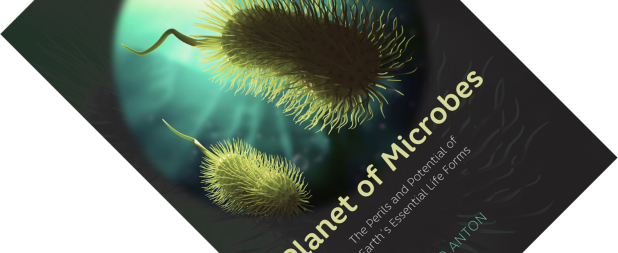What unites deep subterranean caves, hydrothermal vents in the deep sea, our guts, cloud formation, geochemical processes, and astrobiology (the search for life beyond our planet) to name but a few things? Microbes. The tiny, single-celled organisms that we cannot see with the naked eye are everywhere. With Planet of Microbes, Ted Anton makes the point that this world is really theirs, and takes the reader on a tour of the rapid increase in our understanding of their importance, focusing on three major subjects.

“Planet of Microbes: The Perils and Potential of Earth’s Essential Life Forms”, written by Ted Anton, published by The University of Chicago Press in December 2017 (hardback, 327 pages)
First is our long-running quest to understand the origins of life and the question if life exists elsewhere. Anton talks us through the original 1952 Miller-Urey experiment (which showed how complex organic chemicals can be spontaneously formed from simpler inorganic compounds), the controversial figure of Lynn Margulis (whose intellectual heritage includes the theory of endosymbiosis, explaining how complex eukaryotic cells arose from simple prokaryotic cells, see also Symbiogenesis: A New Principle of Evolution), the role of RNA (the single-strand partner of DNA) in early life, the discovery of a completely new kingdom of life, the Archaea, that exist next to bacteria and everything else and can live in very inhospitable environments. This work very much ties in with astrobiology and the search for water and microbial life beyond Earth, including probes send to comets (most recently the Rosetta probe Philae landing on the Churyumov-Gerasimenko comet) and moons in our solar system, the Rovers trundling around on Mars, and the study of comets found on Earth.
The second big topic Anton explores is that of the human microbiome, the community of microbes that lives in and on us. The idea that microbes are not just dangerous pathogens that make us ill but are also necessary allies for our health and well-being has exploded into the popular consciousness in recent years. There have been at least four big pop-science books on the topic in the last three years: Collen’s 10% Human: How Your Body’s Microbes Hold the Key to Health and Happiness, DeSalle & Perkins’s Welcome to the Microbiome: Getting to Know the Trillions of Bacteria and Other Microbes In, On, and Around You, Dietert’s The Human Superorganism: How the Microbiome Is Revolutionizing the Pursuit of a Healthy Life, and Yong’s I Contain Multitudes: The Microbes Within Us and a Grander View of Life. It seems our microbiome can influence our emotions, physical health and behaviour, and overuse of antibiotics is being linked to a rise in obesity, auto-immune diseases, diabetes and psychological disorders (see also Blaser’s Missing Microbes: How Killing Bacteria Creates Modern Plagues). This is a rapidly developing field where there is as much hype as hypothesis. Health fads and snake oil salesmen abound, and in this context Jonathan Eisen’s blog The Tree of Life and his warning of microbiomania are very apt.
The third topic Anton covers is the fundamental roles of microbes in the functioning of our planet, whether in geochemistry, climate, renewing and cleaning soil, or breaking down waste. Synthetic biology as a field has exploded, and there has been a veritable gold rush for commercial applications. Microbes could soon help us create renewable energy, break down chemical and radioactive waste (and maybe even plastic), clean up wastewater, and change the face of agriculture. Especially the many extremophiles (which includes some of the aforementioned Archaea living in inhospitable environments) can snack on pretty much anything.
“The human microbiome […] is a rapidly developing field where there is as much hype as hypothesis”
All this sounds like an awful lot of ground to cover. Anton acknowledges some 150 scientists and researchers whose brains he has picked over the years. Looking at the notes, some of his interviews date back to 1999, though the majority of material seems to have been gathered in the last four years. As a consequence, Planet of Microbes is a high-octane story of discovery. Other than the classic experiments and theories regarding the origins of life, many topics are not treated in any great depth. That the microbiome affects our health is only mentioned rather than explained in detail, so I feel confident that I can pick up some of the aforementioned books and learn a great deal more. Instead, Anton touches on topics, before quickly introducing the next ground-breaking discovery in another field. If the pace sounds frantic, in a way it reflects the incredibly rapid expansion of our knowledge in these fields.
The book is slightly marred by grammatical errors, especially in the first part of the book. You come across sentences where it seems the author wrote down two versions of a sentence and then forgot to delete one of his options, resulting in awkward constructions such as “Ancient cyanobacteria that the made the pungent blue-green algae of swamps and ponds […] (p. 18)”. The other two parts of the book seem to have been proof-read more thoroughly, though some noticeable repetition creeps in in the last few chapters. What the book does have, which I like, is an appendix with two timelines of major discoveries, one dedicated to the results of the various space probes. Readers of Planet of Microbes would benefit from basic background knowledge of biology, as there are no illustrations or a glossary, and Anton defines few things explicitly. Overall, the book provides a very pleasant mix of personal portrayal of the sometimes eccentric researchers in these fields and the surprising discoveries they have made. Its fast-paced narrative succeeded in sucking me in, and I dare say it makes for a microbiological page-turner.
Disclosure: The publisher provided a review copy of this book. The opinion expressed here is my own, however.

or ebook
Other recommended books mentioned in this review:
__________________________________________________________________







Just one such example of “microbiomania” was just published in New Scientist on the sense or nonsense of taking probiotic supplements:
https://www.newscientist.com/article/2178860-probiotics-are-mostly-useless-and-can-actually-hurt-you/
LikeLike